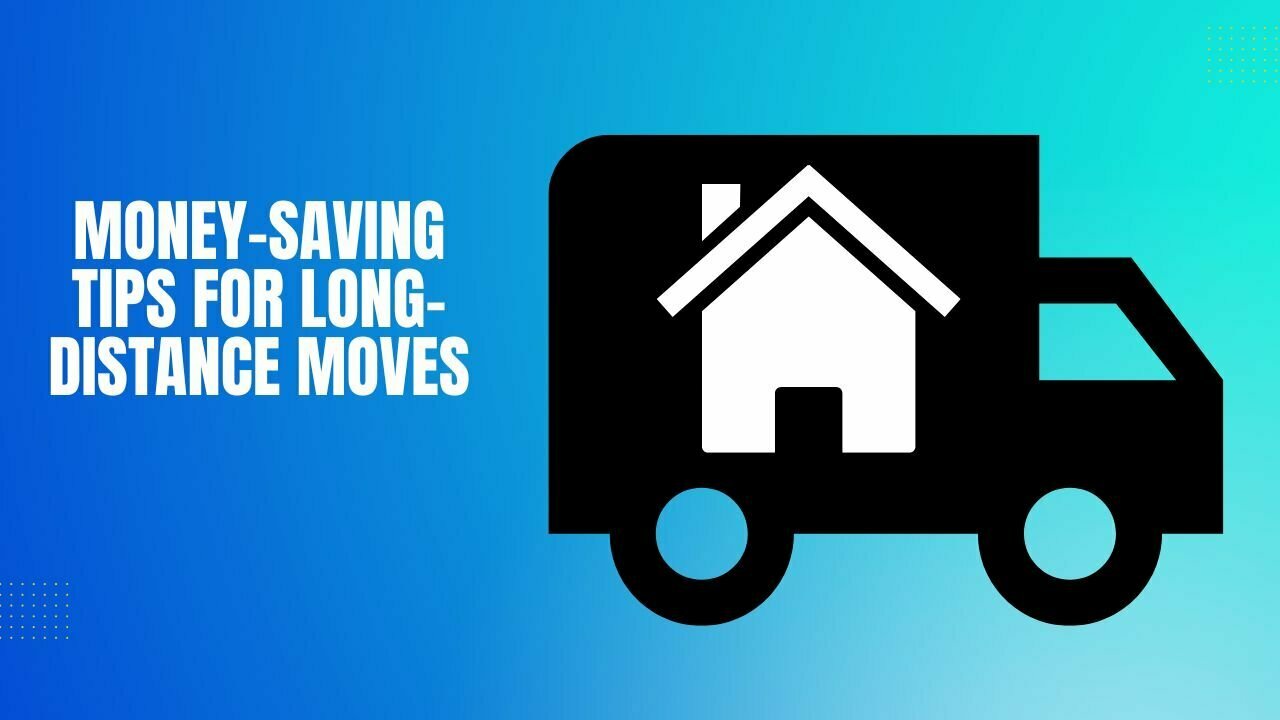The cost of a long-distance move is not just about packing up your things and hitting the road.
There are hidden costs that most people don’t consider when planning a move, and they can really add up.
According to moving.com, the average cost of a long-distance move is around $4,890, but that’s just the tip of the iceberg.
Did you know that you’ll likely have to pay for things like packing materials, insurance, and utility deposits?
And what about the cost of travel and lodging while you’re on the road?
But wait, it gets even worse. The cost of a long-distance move can vary depending on where you’re moving to and from.
For example, if you’re moving from New York City to Los Angeles, the cost could be as much as $10,000!
That’s a lot of money, especially for millennials who are already struggling with student loans and other financial burdens.
Long-distance moving expenses can quickly add up, with factors like distance, weight, the volume of your belongings, and time of year. Hidden expenses like insurance, packing and unpacking fees, and storage fees can also take a toll on your budget. Budget and plan ahead to avoid that.
But don’t worry, I’ve got some money-saving tips that will help you keep your long-distance move affordable.
From packing your own boxes to booking your move during the off-season, there are plenty of ways to cut costs and keep more money in your pocket.
So, let’s dive in!
1. Factors that Affect the Cost of Long-Distance Moving

1.1 Distance and location
One of the biggest factors is the distance and location of your move.
1.1.1 Impact of Distance on transportation costs
The farther you have to move, the more expensive it’s going to be.
This is because transportation costs, such as fuel and maintenance, will increase as the distance grows.
In fact, according to Rocket Mortgage, the average cost of a long-distance move increases by around $0.75 per mile for every 1,000 miles traveled.
1.1.2 Additional costs associated with the location
There are additional costs associated with certain locations that can impact the overall cost of your move.
For example:
- Urban areas may have higher moving and parking fees due to limited space and increased demand for services.
- Rural areas may have higher transportation costs due to limited access and longer travel times.
- Coastal areas may have higher insurance costs due to the risk of hurricanes, flooding, and other natural disasters.
To help you get a better understanding of how distance and location can impact the cost of a long-distance move, I’ve put together this handy table:
| Distance Traveled | Average Cost |
| 100-500 miles | $800-$2,000 |
| 500-1,000 miles | $1,500-$3,500 |
| 1,000-2,000 miles | $2,500-$5,000 |
| 2,000+ miles | $4,000-$10,000+ |
As you can see, the cost can really add up as the distance increases.
And when you factor in the additional costs associated with certain locations, it’s important to plan ahead and budget accordingly.
Trust me, your wallet will thank you!
1.2 Volume and weight of belongings
Basically, the more stuff you have, the more it’s going to cost to move it.
This is because moving companies charge based on the weight and volume of your belongings, as well as the distance of your move.
When my wife and I were making our first inter-continental move, we were charged based on both.
We were charged based on whichever was greater. The size of a 66-pound (30KG) box was the same, and whether you can fit 66 pounds in it or not was immaterial.
There were some boxes for which we paid much more because we were only able to pack 30-45 pounds (15-20 kgs) in them. While some exceeded 66 pounds, and we were charged extra per pound for them.
Oh, we did try to balance and maximize the space-to-weight ratio. But with so many dissimilar items, it was bound to happen.
1.2.1 How volume and weight impact moving costs
To give you a better idea of how volume and weight can impact moving costs, here’s a breakdown of average costs based on the size of a move:
| Move Size | Average Cost |
| Studio/1 Bedroom | $1,000-$2,000 |
| 2-3 Bedroom | $2,000-$6,000 |
| 4+ Bedroom | $5,000-$10,000+ |
As you can see, the cost can vary widely depending on the size of your move.
So, if you’re looking to save money on your long-distance move, one of the best things you can do is reduce the volume and weight of your belongings.
1.2.2 Tips for reducing the volume and weight of belongings
Here are some tips we followed for doing just that:
- Declutter before you move: Go through your belongings and get rid of anything you no longer need or want. This will not only reduce the volume and weight of your move but also save you time and money on packing and unpacking.
- Sell or donate bulky items: If you have furniture or other large items that you don’t want to bring with you, consider selling them or donating them to charity. This will help you save money on transportation costs and potentially even earn some extra cash.
- Use lightweight packing materials: When packing your belongings, opt for lightweight materials like clothing and towels instead of heavy items like books and electronics. This will help reduce the weight of your move and save you money on transportation costs.
1.3 Time of year
Believe it or not, the time of year you choose to move can have a big impact on how much you end up paying.
1.3.1 Seasonal Factors that impact moving costs
Here are some seasonal factors that can impact your moving costs:
- Summer months: These months are the busiest time of year for moving companies, as many families choose to move during the summer break from school. As a result, prices can be higher during these months due to increased demand.
- Winter months: On the other hand, the winter months are typically slower for moving companies, as many people prefer to avoid moving during cold and potentially snowy weather. As a result, prices may be lower during these months due to lower demand.
- Holidays: Moving around major holidays, like Thanksgiving and Christmas, can also impact costs. Many moving companies charge extra fees for moves during these times, so it’s important to factor that into your budget.
1.3.2 Strategies for avoiding peak moving season
So, how can you avoid the peak moving season and potentially save some money?
Here are a few strategies:
- Move during the off-season: If possible, try to plan your move for a less busy time of year, like the fall or winter. You may be able to score lower prices and more flexible scheduling options.
- Schedule your move mid-week: If you can’t avoid moving during peak season, try to schedule your move for a weekday instead of a weekend. Many moving companies charge more for weekend moves, so this can help you save money.
- Book your move early: The earlier you book your move, the better chance you have of securing a lower price. This is especially important during peak season when prices can rise quickly.
2. Hidden Costs of a Long-Distance Move

2.1 Packing and unpacking expenses
One major cost that often gets overlooked is packing and unpacking expenses.
Here are some things to keep in mind when it comes to packing and unpacking costs:
- Cost of packing materials: You’ll need to purchase packing materials like boxes, tape, bubble wrap, and packing paper to protect your belongings during the move. These costs can add up quickly, especially if you have a lot of items to pack.
- Cost of hiring professional packers: If you’re short on time or simply don’t want to deal with the stress of packing, you may choose to hire professional packers to do it for you. While this can be a convenient option, it can also be quite costly. According to move.org, the average cost of hiring professional packers is $420-$480 for a one-bedroom apartment and can go up to $1,000 or more for larger homes.
So, how can you save money on packing and unpacking expenses?
Here are a few tips that we used:
- Use free packing materials: Instead of buying all of your packing materials, try to find free boxes and packing supplies from places like Craigslist or your local grocery store.
- Pack yourself: While it may take more time and effort, packing your belongings yourself can save you a lot of money in professional packing fees.
- Declutter before you pack: The less stuff you have to pack, the less money you’ll have to spend on packing materials and potentially even on the size of your moving truck. Take the time to declutter before you start packing to save some money.
By being mindful of the costs associated with packing and unpacking, you can potentially save yourself hundreds of dollars on your long-distance move.
And as we know, every penny counts when it comes to personal finance for millennials!
2.2 Insurance and liability coverage
One of the most important aspects of this topic is insurance and liability coverage.
Many people don’t consider the additional costs associated with insurance, which can add up quickly if you’re not careful.
2.2.1 Types of Insurance and liability coverage
First things first, let’s talk about the types of insurance and liability coverage you should consider when planning a long-distance move. Here’s a breakdown.
Types of Insurance and Liability Coverage:
- Moving insurance: This covers any damage to your belongings during the move. It’s important to note that basic coverage is usually included in the moving contract, but it may not be enough to cover the full value of your belongings. Consider purchasing additional coverage if you have valuable items.
- Liability coverage: This protects you in case any damage occurs to your property or someone is injured during the move. Again, basic coverage is usually included, but additional coverage may be necessary.
b. Additional costs associated with insurance
Additional Costs Associated with Insurance:
- Premiums: The cost of the insurance itself will vary depending on the type and amount of coverage you choose. Do your research and shop around for the best rates.
- Deductibles: Many insurance policies have deductibles, which means you’ll need to pay a certain amount out of pocket before the insurance kicks in. Make sure you understand what your deductibles are and plan accordingly.
- Extra fees: Some moving companies may charge extra fees for certain types of coverage or for providing additional insurance. Be sure to ask about any potential extra fees before signing any contracts.
Now, you may be wondering if all this insurance is really necessary. The answer is yes!
It’s always better to be safe than sorry, and insurance can provide valuable protection and peace of mind during the stressful process of moving.
According to a survey by the American Moving & Storage Association, the average cost of an interstate move is $4,300.
That’s a significant amount of money, and it’s important to protect your investment.
Some moving companies also provide their own insurance or are tied up to an insurance company. You can check with them.
Some also have insurance in-built into their pricing itself. Do check that as well. It will be redundant to take insurance separately if that’s the case.
2.3 Storage fees
Another cost that people often overlook is storage fees.
Here’s what you need to know:
2.3.1 Reasons for needing storage during a move
Reasons for Needing Storage During a Move:
- Timing: You may need to move out of your current place before your new place is ready.
- Downsizing: If you’re downsizing, you may not have enough space for all your belongings in your new place.
- Renovations: If you’re doing renovations in your new place, you may need to store your belongings until the work is done.
2.3.2 Cost of Short-term and Long-term Storage
Cost of Short-term and Long-term Storage:
- Short-term storage: Short-term storage typically refers to storage needed for less than six months. The average cost of short-term storage is $90 to $180 per month, depending on the size of the unit and the location.
- Long-term storage: Long-term storage typically refers to storage needed for six months or more. The average cost of long-term storage is $70 to $180 per month, depending on the size of the unit and the location.
It’s important to note that these costs can vary greatly depending on the location and the size of the unit.
For example, storage in urban areas tends to be more expensive than in rural areas.
So, how can you save money on storage fees during a long-distance move?
Here are a few tips:
- Get rid of what you don’t need: The less you need to store, the less you’ll pay in storage fees. Take the time to go through your belongings and get rid of anything you don’t need or want anymore.
- Shop around: Don’t settle for the first storage facility you find. Shop around and compare prices to find the best deal.
- Use portable storage: Portable storage units are a convenient option because they can be delivered to your doorstep and picked up when you’re ready. They can also be less expensive than traditional storage units.
3. Unforeseen Expenses During a Long-Distance Move

3.1 Travel expenses
Moving long-distance can come with some unforeseen expenses, and one of the biggest is travel expenses.
Let’s take a closer look:
3.1.1 Cost of gas or airfare
Cost of Gas or Airfare:
- Gas: If you’re driving to your new location, you’ll need to factor in the cost of gas. The cost of gas varies depending on the location and the vehicle, but the average cost of gas in the US is currently around $3.00 per gallon.
- Airfare: If you’re flying to your new location, you’ll need to factor in the cost of airfare. The cost of airfare varies depending on the location and the time of year, but the average cost of a domestic flight in the US is currently around $350.
3.1.2 Cost of Accommodations and Meals
Cost of Accommodations and Meals:
- Accommodations: If your move requires an overnight stay, you’ll need to factor in the cost of accommodations. The cost of accommodations varies depending on the location and the type of lodging, but the average cost of a hotel room in the US is currently around $130 per night.
- Meals: You’ll also need to factor in the cost of meals during your travel. The cost of meals varies depending on the location and the type of restaurant, but the average cost of a meal in the US is currently around $13.
So, how can you save money on travel expenses during a long-distance move?
Here are a few tips that we followed:
- Be flexible with your travel dates: By being flexible with your travel dates, you may be able to find cheaper flights or accommodations.
- Book early: The earlier you book your travel arrangements, the more likely you are to get a better deal.
- Use loyalty programs and discounts: If you have frequent flyer miles or hotel rewards points, consider using them to save on travel expenses. You can also look for discounts and deals online.
- Pack your own meals: Bringing your own snacks and meals can save you money on food expenses during your travel.
3.2 Cleaning and repairs
Another unforeseen expense during a long-distance move can be cleaning and repairs.
Let’s take a closer look:
3.2.1 Cost of Cleaning and Repairs for Old and New Homes
Cost of Cleaning and Repairs for Old and New Homes:
- Old Home: If you’re moving out of an old home, you’ll likely need to do some cleaning and repairs before you can sell or rent it. The cost of cleaning and repairs varies depending on the condition of the home, but the average cost of deep cleaning an old home is around $250-$350, and the average cost of repairs is around $2,500.
- New Home: If you’re moving into a new home, you may need to do some cleaning or repairs before you can move in. The cost of cleaning and repairs varies depending on the condition of the home, but the average cost of deep cleaning a new home is around $200-$300, and the average cost of repairs is around $1,500.
3.2.2 Additional costs for damages or repairs
Additional Costs for Damages or Repairs:
- Damages: If your old or new home has any damages, such as broken windows or damaged flooring, you’ll need to factor in the cost of repairs. The cost of damages varies depending on the severity of the damage and the materials needed for repairs.
- Repairs: If your old or new home needs repairs, such as replacing a leaky faucet or fixing a broken air conditioning unit, you’ll need to factor in the cost of repairs. The cost of repairs varies depending on the complexity of the repair and the materials needed.
So, how can you save money on cleaning and repair expenses during a long-distance move?
Here are a few tips that we always follow:
- DIY as much as possible: If you’re handy, consider doing some of the cleaning and repairs yourself to save on labor costs.
- Get multiple quotes: When hiring professionals for cleaning or repairs, get multiple quotes to find the best price.
- Budget for potential damages: Be prepared for potential damages or repairs by budgeting extra money for these expenses.
- Negotiate with buyers or sellers: If you’re selling or buying a home, negotiate with the other party to split the cost of cleaning or repairs.
If you do this right, you can potentially save hundreds of dollars.
3.3 Miscellaneous expenses
3.3.1 Cost of mail forwarding and changing utilities
You may not realize it, but updating your address with the post office and all your utility companies can add up quickly.
On average, it costs around $1 per mile for mail forwarding services, and changing utilities can cost around $200 to $300, depending on where you live and which companies you use.
To keep these costs down, try to plan ahead and change your address as soon as possible.
Also, be sure to compare prices between different utility providers to find the most affordable options.
3.3.2 Cost of replacing items lost or damaged during the move
Unfortunately, this is a common occurrence during long-distance moves.
On average, people spend around $1,170 on replacing lost or damaged items during a move.
To save money, consider packing your belongings carefully and using sturdy boxes and packing materials.
Also, make sure to hire a reputable moving company that provides insurance coverage for lost or damaged items.
This way, if anything does go wrong, you’ll be covered and won’t have to spend as much money out of pocket.
In summary, here are some money-saving tips to keep in mind when it comes to the miscellaneous expenses of a long-distance move:
- Plan ahead and update your address with the post office and utility companies as soon as possible.
- Compare prices between different utility providers to find the most affordable options.
- Pack your belongings carefully and use sturdy boxes and packing materials.
- Hire a reputable moving company that provides insurance coverage for lost or damaged items.
4. Budgeting for Long-Distance Moving Costs

4.1 Strategies for Creating a Moving Budget
4.1.1 Estimate expenses and create a budget
Firstly, you’ll want to estimate your expenses and create a budget. This includes things like the cost of a moving truck, packing supplies, and gas.
On average, a long-distance move can cost around $4,000, but this can vary depending on how far you’re moving and how much stuff you have.
To create your budget, start by making a list of all the expenses you’ll incur during your move.
Then, use a spreadsheet or budgeting app to track your spending and make sure you’re staying within your budget.
It’s important to be realistic about your expenses and leave some wiggle room for unexpected costs.
4.1.2 Consider additional savings or income sources
Secondly, consider additional savings or income sources.
For example, you could sell some of your belongings before your move to make some extra cash.
Or, you could look into ways to reduce your current expenses, such as canceling unnecessary subscriptions or eating out less frequently.
To help you get started, here are some strategies for creating a moving budget:
- Make a list of all your expenses, including the cost of a moving truck, packing supplies, and gas.
- Use a spreadsheet or budgeting app to track your spending and make sure you’re staying within your budget.
- Be realistic about your expenses and leave some wiggle room for unexpected costs.
- Look for ways to save money or make extra cash, such as selling belongings or reducing current expenses.
By following these strategies, you can create a realistic budget for your long-distance move and avoid any financial surprises along the way.
4.2 Tips for saving money on long-distance moving costs
Firstly, consider negotiating with moving companies. You can get quotes from multiple companies and try to negotiate a lower price.
According to a survey by HomeAdvisor, people who negotiate with moving companies can save up to 30% on their moving costs.
This is a fundamental way we always use to lower our moving costs. I spend at least 1 day on the phone with dozens of companies to get the best deal.
Secondly, DIY moving options can also reduce costs.
You can rent a moving truck and do the packing and loading yourself, or hire labor-only movers to help with the heavy lifting.
This can save you money compared to hiring a full-service moving company.
To help you save money on your long-distance move, here are some tips we always follow:
- Get quotes from multiple moving companies and negotiate for a lower price.
- Consider DIY moving options, such as renting a moving truck or hiring labor-only movers.
- Pack and label your items yourself to save on packing costs.
- Sell or donate items you no longer need to reduce the amount of stuff you’re moving.
- Look for discounts on moving supplies, such as free boxes from local stores.
Bottom Line…
I hope you found this article on the shocking truth about the cost you didn’t know of long-distance moves eye-opening.
It’s no secret that moving can be a stressful and expensive experience, especially when you’re moving across the country.
Additionally, hidden costs can quickly add up and catch you off guard.
According to recent research, the average cost of a long-distance move is around $4,300.
However, that number can vary greatly depending on various factors such as the distance, the size of your household, and the time of year.
And that’s not even taking into account the hidden costs like packing supplies, rental truck fuel, and unexpected fees.
But, there are ways to save money on your long-distance move.
One of the best ways is to declutter and sell or donate items you no longer need.
This can not only save you money on packing supplies and transportation costs but also earn you some extra cash to put toward your move.
Another great money-saving tip is to plan your move during the off-season.
Moving during the summer months or on weekends can be more expensive due to high demand, so consider moving during the fall or winter months when prices are typically lower.
And don’t forget to shop around for the best deals on rental trucks and moving companies. Compare prices and read reviews to ensure you’re getting the best value for your money.
In conclusion, moving can be expensive, but with some careful planning and smart money-saving tips, you can keep costs under control and make your long-distance move a success.
I hope these tips help you save money and reduce stress during your upcoming move as they did to me.
Happy moving!
